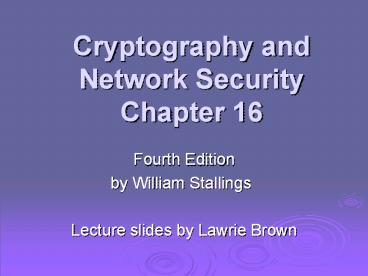Cryptography and Network Security Chapter 16 - PowerPoint PPT Presentation
Title:
Cryptography and Network Security Chapter 16
Description:
If a secret piece of news is divulged by a spy before the time is ripe, he must ... can use arithmetic in prime fields or elliptic curve fields. ISAKMP ... – PowerPoint PPT presentation
Number of Views:1266
Avg rating:3.0/5.0
Title: Cryptography and Network Security Chapter 16
1
Cryptography and Network SecurityChapter 16
- Fourth Edition
- by William Stallings
- Lecture slides by Lawrie Brown
2
Chapter 16 IP Security
- If a secret piece of news is divulged by a spy
before the time is ripe, he must be put to death,
together with the man to whom the secret was
told. - The Art of War, Sun Tzu
3
IP Security
- have a range of application specific security
mechanisms - eg. S/MIME, PGP, Kerberos, SSL/HTTPS
- however there are security concerns that cut
across protocol layers - would like security implemented by the network
for all applications
4
IPSec
- general IP Security mechanisms
- provides
- authentication
- confidentiality
- key management
- applicable to use over LANs, across public
private WANs, for the Internet
5
IPSec Uses
6
Benefits of IPSec
- in a firewall/router provides strong security to
all traffic crossing the perimeter - in a firewall/router is resistant to bypass
- is below transport layer, hence transparent to
applications - can be transparent to end users
- can provide security for individual users
- secures routing architecture
7
IP Security Architecture
- specification is quite complex
- defined in numerous RFCs
- incl. RFC 2401/2402/2406/2408
- many others, grouped by category
- mandatory in IPv6, optional in IPv4
- have two security header extensions
- Authentication Header (AH)
- Encapsulating Security Payload (ESP)
8
IPSec Services
- Access control
- Connectionless integrity
- Data origin authentication
- Rejection of replayed packets
- a form of partial sequence integrity
- Confidentiality (encryption)
- Limited traffic flow confidentiality
9
Security Associations
- a one-way relationship between sender receiver
that affords security for traffic flow - defined by 3 parameters
- Security Parameters Index (SPI)
- IP Destination Address
- Security Protocol Identifier
- has a number of other parameters
- seq no, AH EH info, lifetime etc
- have a database of Security Associations
10
Authentication Header (AH)
- provides support for data integrity
authentication of IP packets - end system/router can authenticate user/app
- prevents address spoofing attacks by tracking
sequence numbers - based on use of a MAC
- HMAC-MD5-96 or HMAC-SHA-1-96
- parties must share a secret key
11
Authentication Header
12
Transport Tunnel Modes
13
Encapsulating Security Payload (ESP)
- provides message content confidentiality
limited traffic flow confidentiality - can optionally provide the same authentication
services as AH - supports range of ciphers, modes, padding
- incl. DES, Triple-DES, RC5, IDEA, CAST etc
- CBC other modes
- padding needed to fill blocksize, fields, for
traffic flow
14
Encapsulating Security Payload
15
Transport vs Tunnel Mode ESP
- transport mode is used to encrypt optionally
authenticate IP data - data protected but header left in clear
- can do traffic analysis but is efficient
- good for ESP host to host traffic
- tunnel mode encrypts entire IP packet
- add new header for next hop
- good for VPNs, gateway to gateway security
16
Combining Security Associations
- SAs can implement either AH or ESP
- to implement both need to combine SAs
- form a security association bundle
- may terminate at different or same endpoints
- combined by
- transport adjacency
- iterated tunneling
- issue of authentication encryption order
17
Combining Security Associations
18
Key Management
- handles key generation distribution
- typically need 2 pairs of keys
- 2 per direction for AH ESP
- manual key management
- sysadmin manually configures every system
- automated key management
- automated system for on demand creation of keys
for SAs in large systems - has Oakley ISAKMP elements
19
Oakley
- a key exchange protocol
- based on Diffie-Hellman key exchange
- adds features to address weaknesses
- cookies, groups (global params), nonces, DH key
exchange with authentication - can use arithmetic in prime fields or elliptic
curve fields
20
ISAKMP
- Internet Security Association and Key Management
Protocol - provides framework for key management
- defines procedures and packet formats to
establish, negotiate, modify, delete SAs - independent of key exchange protocol, encryption
alg, authentication method
21
ISAKMP
22
ISAKMP Payloads Exchanges
- have a number of ISAKMP payload types
- Security, Proposal, Transform, Key,
Identification, Certificate, Certificate, Hash,
Signature, Nonce, Notification, Delete - ISAKMP has framework for 5 types of message
exchanges - base, identity protection, authentication only,
aggressive, informational
23
Summary
- have considered
- IPSec security framework
- AH
- ESP
- key management Oakley/ISAKMP































